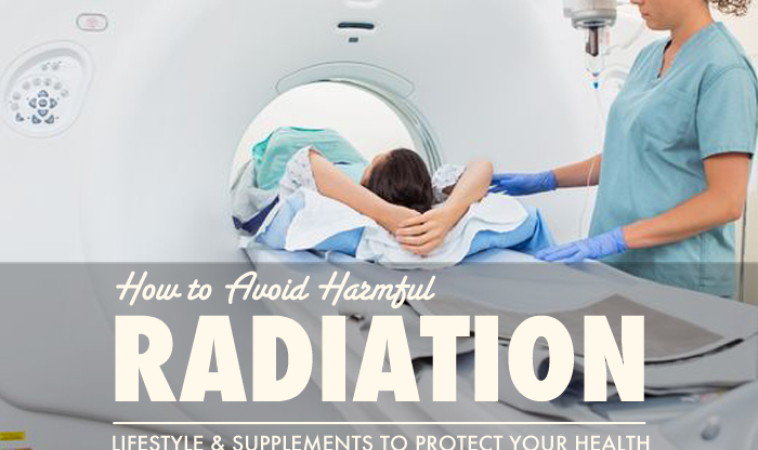Sarah A LoBisco, ND
@DrLoBisco
Can Lifestyle and Supplements Protect Us From These Detrimental Radiation Effects?
We can’t escape radiation exposure.1-7 It’s present naturally in our environment, in some of the foods we eat, our water supply, medical imaging, nuclear medicine, radioactive power generation, consumer products, military and industrial sources, and, of course, the cell phone attached to our dominant hand.1In fact, electromagnetic radiation (EMR) is one of the four fundamental forces of nature, which also includes gravity, the strong force, and the weak force. It is these four forces that are generally agreed to be the most basic interactions in the universe. 2-3
Radiation sounds pretty important and useful then, right? But, do you know what can happen with too much of a good thing? First, let’s start by defining what EMR is, and then we’ll review how it can impact our health. Finally, I’ll leave you with some hopeful remedies to radiation blues.
What is Electromagnetic Radiation (EMR)?
Electromagnetic radiation (EMR) is classified according to its wavelength, frequency, and photon energies along the electromagnetic spectrum (EMS). Below are the different groupings of EMR in order of increasing wavelengths: 5-8
- Gamma radiation
- X-ray radiation
- Ultraviolet radiation
- Visible radiation (light detected by the human eye)
- Infrared radiation
- Terahertz radiation ( a non-ionizing form of EMR between IR and microwave that is becoming more studied)8
- Microwave radiation
- Radio waves
Ionizing and Non-Ionizing Radiation
EMR can further be broadly organized into two general categories, ionizing and non-ionizing radiation which is also dependent on its placement on the energy spectrum. 5-13 Ionizing radiation is appropriately termed due to the fact that it carries enough energy to “ionize” atoms or molecules by freeing electrons. In other words, it has the capacity to completely remove an electron from an atom or molecule. Examples of ionizing radiation include gamma rays, X-rays, and the higher ultraviolet part of the electromagnetic spectrum.7, 9-10
According to the Public Health Agency for Toxic Substances and Disease Registry (U.S. Department of Health and Human Services):
Expo-sure to high doses of ionizing radiation can result in skin burns, hair loss, nausea, birth defects, illness, and death. How you are affected depends on how much ionizing radiation you received and over what period of time, and personal factors such as sex, age at the time of exposure, and your health and nutritional status.9
It is well agreed upon that ionizing radiation can cause detrimental health effects, such as those above as well as genetic alterations and cancer. The National Library of Medicine’s Hazardous Substances Data Bank states, “X-radiation and gamma radiation are known to be human carcinogens based on sufficient evidence of carcinogenicity from studies in humans.”10
There is some controversy; however, on non-ionizing radiation’s health implications, including the radiofrequency effects of cell phones. Still, non-ionizing radiation has been classified as possibly carcinogenic by the International Agency for Research on Cancer (IARC).1-121 I am convinced enough to take the precautionary route and use methods to mitigate exposure which I reviewed previously here. The remainder of this article will mostly focus on protecting ourselves from ionizing radiation, though a lot of the same mechanisms involved can be applied to non-ionizing radiation.
Protecting Ourselves from Excess Radiation
According to the World Health Organization (WHO), a combination of the dose and source of radiation will determine radiation effects.1 Considering the fact that it’s very difficult to get a full estimate of ongoing radiation exposure, you can help prevent excess exposure in the following ways:7,13
- minimizing X-rays, CT scans, and air travel
- avoiding food and water contaminated by nuclear or coal-fired plants
- testing water for radon and other nuclear contaminates and filtering them out (you can use various filters such as reverse osmosis; however, consider re-mineralization with this method or an alternate form, such as a carbon filter)14
- avoiding tanning beds and enjoying the many benefits from adequate sun exposure in a limited amount (biophotons, vitamin D synthesis, day and nighttime circadian rhythm entrainment) and protecting yourself with clothing, hats, and non-toxic sunscreen when in the sun for extended periods of time
- eating a diet that is nutrient dense and rich in plant-based foods for their protective phytonutrients and supportive nutrients 7
Can We Protect Ourselves With Supplements, Pills, & Phytonutrients?
Besides lifestyle and dietary measures, there have been a variety of substances and natural supplements that have some evidence in mitigating the negative consequences of too much radiation exposure. Below is a summary of some of them:
- Ocimum sanctum (Tulsi)
Tulsi is known in Ayurveda medicine as an adaptogen and anti-inflammatory herb. It has been shown to have beneficial effects as an antioxidant. Tulsi’s two flavonoids, orientin and vicenin-1, were shown to be protective against radiation effects in rodents. It was also been shown in vivo to induce endogenous antioxidants and suppress lipid peroxidation in the liver. 15-16
- Gallic Acid (GA)
One study reported on several mechanisms in which gallic acid (GA) may be beneficial to protect against radiation with rodents. These include reducing radiation-induced cellular DNA damage in various mice cells, preventing decreases in antioxidant enzymes (glutathione peroxidase and nonprotein thiol glutathione), inhibition of chromosomal aberrations and micronucleus formation, assistance in DNA repair, and preventing weight loss and mortality when the animals were exposed to lethal doses. 17
- Flaxseeds (FS)
Known for their high omega-3 content and fiber, flaxseeds may also have another claim to fame. In a murine model, study researchers concluded, “Dietary FS is protective against pulmonary fibrosis, inflammation and oxidative lung damage in a murine model. Moreover, in this model, tumor radioprotection was not observed. FS lignans exhibited potent radiation-induced ROS scavenging action. Taken together, these data suggest that dietary flaxseed may be clinically useful as an agent to increase the therapeutic index of thoracic XRT by increasing the radiation tolerance of lung tissues.”18
- Miso Soup
Though not a supplement, miso soup has been shown in several rodent trials to reduce negative radiation effects when compared to a control in regards to preventing tumor formation and preserving intestinal health from exposure to it. 19-20
- Fish oil
Fish oil has also been shown in several rodent studies to protect against radiation damage. Specifically, this was in regards to protecting rats’ brains and immune system. 21-22
- Taurine
Several mechanisms are involved in protection of radiation effects with taurine. According to one study, taurine has the following actions:
(1) during the exposure to ionizing radiation by functioning as an antioxidant, but perhaps more because it counteracts the prooxidant catalytic effect of iron rather than functioning as an important scavenger of harmful molecules itself, (2) after the ionizing radiation exposure by helping to reduce the intensity of the post-traumatic inflammatory response, and thus reducing the extent of tissue damage that develops because of severe inflammation rather than as a direct effect of the ionizing radiation per se, (3) by functioning as a growth factor helping to enhance the growth rate of leukocytes and leukocyte progenitor cells and perhaps also of other rapidly proliferating cell types, such as enterocyte progenitor cells, which may be important for immunological recovery and perhaps also for rapid repair of various damaged tissues, especially in the intestines, and (4) by functioning as an antifibrogenic agent.23
- Lycopene and Antioxidants
Several studies have shown links between lycopene and carotenoids in the blood stream and antioxidant and ultraviolet protective effects. 24-25
- Other Phytonutrients
According to an article in GreenMedInfo, which has extensive references that are fun to cross-reference; the following phytonutrients have been demonstrated to also have radioprotective effects. The author states:
Several phytonutrients and their sources have been researched for their ability to protect cells from radiation damage including holy basil, carotenoids (e.g. lycopene, alpha- and beta-carotene, lutein, astaxanthin), resveratrol, silibinin/silymarin, green tea and black tea polyphenols, broccoli sprout glucoraphanin and sulforaphane, curcumin, grapes, grape seed proanthocyanidins, terminalia chebula, aged garlic extract, dark chocolate flavonols, black soybean, blackberry, blueberry, strawberry, grapefruit, fennel seed, ginseng, walnut, vanillin, omega-3 fatty acids, spirulina, and vitamin C.7
You can receive even more ideas and find references by accessing the full article here: http://www.greenmedinfo.com/blog/tracking-mitigating-radiation-poisoning-inside-out-1
 Sarah Lobisco, ND, is a graduate of the University of Bridgeport’s College of Naturopathic Medicine (UBCNM). She is licensed in Vermont as a naturopathic doctor and holds a Bachelor of Psychology from State University of New York at Geneseo. Dr. LoBisco is a speaker on integrative health, has several publications, and is a certification candidate in functional medicine. Dr. LoBisco currently incorporates her training as a naturopathic doctor and functional medicine practitioner through writing, researching, private practice, and through her independent contracting work for companies regarding supplements, nutraceuticals, essential oils, and medical foods. She has a small, private wellness consultation practice through telephone and Skype. Dr. LoBisco also enjoys continuing to educate and empower her readers through her blogs and social media. Her recent blog can be found at www.dr-lobisco.com.
Sarah Lobisco, ND, is a graduate of the University of Bridgeport’s College of Naturopathic Medicine (UBCNM). She is licensed in Vermont as a naturopathic doctor and holds a Bachelor of Psychology from State University of New York at Geneseo. Dr. LoBisco is a speaker on integrative health, has several publications, and is a certification candidate in functional medicine. Dr. LoBisco currently incorporates her training as a naturopathic doctor and functional medicine practitioner through writing, researching, private practice, and through her independent contracting work for companies regarding supplements, nutraceuticals, essential oils, and medical foods. She has a small, private wellness consultation practice through telephone and Skype. Dr. LoBisco also enjoys continuing to educate and empower her readers through her blogs and social media. Her recent blog can be found at www.dr-lobisco.com.
References:
- WHO. Ionizing Radiation. Environmental Radiation. 2015. Available at: http://www.who.int/ionizing_radiation/about/what_is_ir/en/index2.html
- University of Tennessee. The Fundamental Forces of Nature. http://csep10.phys.utk.edu/astr162/lect/cosmology/forces.html
- Georgia State University. Fundamental Forces. HyperPhysics. http://hyperphysics.phy-astr.gsu.edu/hbase/forces/funfor.html
- Wikepedia. Fundamental Interaction. Wikepedia.org. Modified September 27, 2015. https://en.wikipedia.org/wiki/Fundamental_interaction
- Berkeley Lab. Electromagnetic Spectrum. Available at: http://www2.lbl.gov/MicroWorlds/ALSTool/EMSpec/EMSpec2.html. Accessed September 28, 2015.
- Wikepedia. Electromagnetic Spectrum. Wikepedia.org. Modified September 28, 2015. Available at: https://en.wikipedia.org/wiki/Electromagnetic_spectrum
- Di Lugilo BE. Tracking & Mitigating Radiation Poisoning from the Inside Out. Green Med Info. August 29, 2015. http://www.greenmedinfo.com/blog/tracking-mitigating-radiation-poisoning-inside-out-1
- Hammers L. New Device Converts DC Electric Field to Terahertz Radiation. AIP. August 14, 2015. https://www.aip.org/publishing/journal-highlights/new-device-converts-dc-electric-field-terahertz-radiation
- U.S. Department of Health and Human Services. Public Health Service Agency for Toxic Substances and Disease Registry. ATSDR. Ionizing Radiation. September 1999. Available at: http://www.atsdr.cdc.gov/toxfaqs/tfacts149.pdf
- National Library of Medicine, National Institutes of Health. Hazardous Substances Data Bank. Ionizing Radiation. Modified August 16, 2014. Available at: https://ntp.niehs.nih.gov/ntp/roc/content/profiles/ionizingradiation.pdf
- IARC. Non-Ionizing Radiation, Part 2: Radiofrequency Electromagnetic Fields. 2011. http://www.iarc.fr/en/media-centre/pr/2011/pdfs/pr208_E.pdf
- Wikepedia. Non-Ionizing Radiation. Wikepedia.org. Modified July 22, 2015. https://en.wikipedia.org/wiki/Non-ionizing_radiation
- Environmental Protection Agency. Calculate Your Radiation Dose. EPA.org. September 16, 2015. Available at: http://www.epa.gov/radiation/understand/calculate.html
- University of Nebraska-Lincoln Extension, Agriculture and Natural Resources. Reverse Osmosis. 2008. http://ianrpubs.unl.edu/live/g1490/build/g1490.pdf
- Devi PU. Radioprotective effect of leaf extract of Indian medicinal plant Ocimum sanctum. Indian Journal of Experimental Biology.1995; 33(3): 205-208.
- Cohen M. Plant Based Radiation Protection: Tulsi. GreenMed Info. November 18, 2013. Available at: http://www.greenmedinfo.com/blog/plant-based-radiation-protection-tulsi
- Nair GG, Nair CKK. Radioprotective Effects of Gallic Acid in Mice. BioMed Research International. 2013. doi:10.1155/2013/953079.
- Lee JC, Krochak R, Blouin A, et al. Dietary flaxseed prevents radiation-induced oxidative lung damage, inflammation and fibrosis in a mouse model of thoracic radiation injury. Cancer Biol Ther. 2009 Jan;8(1):47-53.
- Watanabe H. Beneficial Biological Effects of Miso with Reference to Radiation Injury, Cancer and Hypertension. Journal of Toxicologic Pathology. 2013;26(2):91-103. doi:10.1293/tox.26.91.
- Ohara M, Lu H, Shiraki K, Ishimura Y, Uesaka T, Katoh O, Watanabe H. Radioprotective effects of miso (fermented soy bean paste) against radiation in B6C3F1 mice: increased small intestinal crypt survival, crypt lengths and prolongation of average time to death. Hiroshima J Med Sci. 2001 Dec;50(4):83-6.
- Fish oil omega-3 fatty acids reduce the severity of radiation-induced oxidative stress in the rat brain. Int J Radiat Biol. 2014 Dec;90(12):1179-83. doi: 10.3109/09553002.2014.934928. Epub 2014 Jul 7.
- Dietary eicosapentaenoic acid prevents systemic immunosuppression in mice induced by UVB radiation. Radiat Res. 2001 Jul;156(1):36-44.
- Christophersen OA. Radiation protection following nuclear power accidents: a survey of putative mechanisms involved in the radioprotective actions of taurine during and after radiation exposure. Microbial Ecology in Health and Disease. 2012;23:10.3402/mehd.v23i0.14787. doi:10.3402/mehd.v23i0.14787.
- Pirayesh Islamian J, Mehrali H. Lycopene as A Carotenoid Provides Radioprotectant and Antioxidant Effects by Quenching Radiation-Induced Free Radical Singlet Oxygen: An Overview. Cell Journal (Yakhteh). 2015;16(4):386-391.
- Skin lycopene is destroyed preferentially over beta-carotene during ultraviolet irradiation in humans. Journal of Nutrition. August 2015. 125(7):1854-9. Available at: http://jn.nutrition.org/content/125/7/1854.long
















